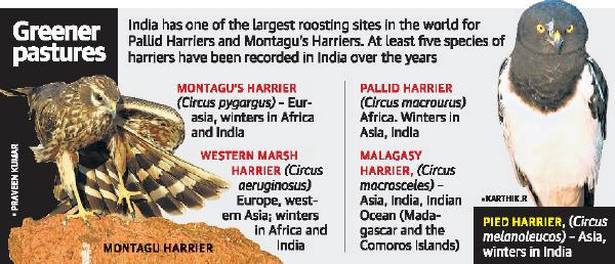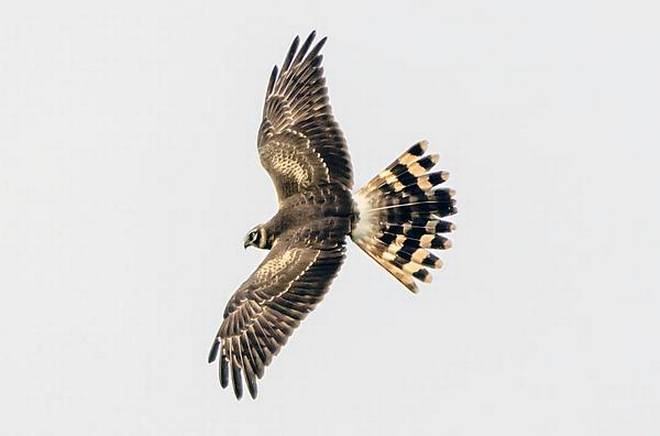Harriers: India
This is a collection of articles archived for the excellence of their content. |
Threats to livelihood
Disappearance of grasslands

From: Mohit M Rao, Flying into trouble: Harrier birds decline as grasslands disappear, July 15, 2018: The Hindu
Harrier birds, a migratory raptor species that regularly visits vast swathes of India, are declining. This may foretell lurking dangers to the country’s grasslands.
The “poorly studied” species is the focus of a study by two researchers from the Ashoka Trust for Research in Ecology and Environment (ATREE), who compared previous records of sightings with more current observations to determine what many had feared. Every winter, several species of harrier birds travel thousands of kilometres to escape frigid Central Asia for the grasslands of the subcontinent.
Researchers T. Ganesh and M.B. Prashanth collated published data, unpublished accounts and their own field research on roosting harriers to analyse trends in their population since the mid-1980s. At least five species of harriers were recorded in India over the years; India has one of the largest roosting sites in the world for Pallid Harriers and Montagu’s Harriers.
The researchers focused on six of the 15 major roosting sites in six States, where consistent observations had been made for over five years. While a general declining trend was observed in all the monitored sites, researchers noted the most dramatic changes at the Rollapadu Bustard Sanctuary in Andhra Pradesh's Kurnool district, one of the largest. In the mid-1990s, an estimated 1,000 birds roosted here. By 2016, the number was down to less than 100 birds. In Hessarghatta on the outskirts of Bengaluru, Western Marsh Harriers declined significantly, leaving the area nearly deserted.
Less than half
The importance of area protection can be seen in the number of birds. While there is a median count of 125 harriers in protected areas, it’s less than half that number — 48 — in unprotected areas. The study notes that the population of the species in Central Asia has not seen any drastic changes.
So, do these results indicate that the migrant birds have found better places to roost than India? The researchers think this is improbable. “These are traditional roosting sites for harrier species, so we don’t know what has happened. Considering the overall decline is spread out, the numbers could signify a lowering trend in populations. It is a major concern, and it’s unlikely they have moved elsewhere in India,” said Mr. Ganesh, remarking on the possibility of a combination of multiple factors for the fall.
Pesticide use
The gravest concern is the loss of grasslands, either to urbanisation or to agriculture. In February-March, peak season for the arrival of the birds, farmlands are burnt or over-grazed. Of the 15 roosting sites surveyed, eight no longer exist as grasslands, and only five are protected.
Excessive use of pesticides in farms in and around the roosting sites could also be a reason for the lowered population counts. In crops such as cotton, the use of pesticides kills grasshoppers, the harriers’ primary prey, and could lead to mortality of the birds themselves as they are on the top of the food chain, Mr. Ganesh explained.
Globally, of the 16 harrier species, only two are listed as endangered by the International Union for Conservation of Nature, even though most of them are declining. While more intensive research is needed, Mr. Ganesh said, the conservation of India’s grasslands could be a start in protecting the magnificent migrators.
